Why you can trust Tom's Hardware
Here we'll take a closer look at the Ryzen 7 5800X's boost clock mechanisms. Our testing shows that the chip exceeds its advertised clock speeds within the power limits of the AM4 socket, but it generates quite a bit of heat in the process.
As per our normal routine, we put AMD's boost clocks to the test in both single- and multi-threaded workloads (methodology here). The lightly-threaded test regimen is designed to extract the highest boost clock rates possible as we step through ten iterations of the LAME encoder, then single-threaded POV-Ray and Cinebench runs, PCMark 10, and GeekBench. To keep the charts 'clean,' we only plot the maximum and minimum frequency recorded on any one core during the test.
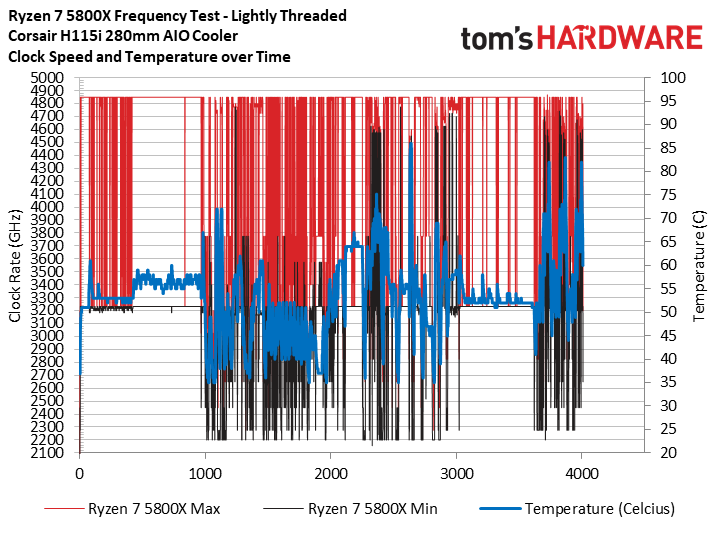
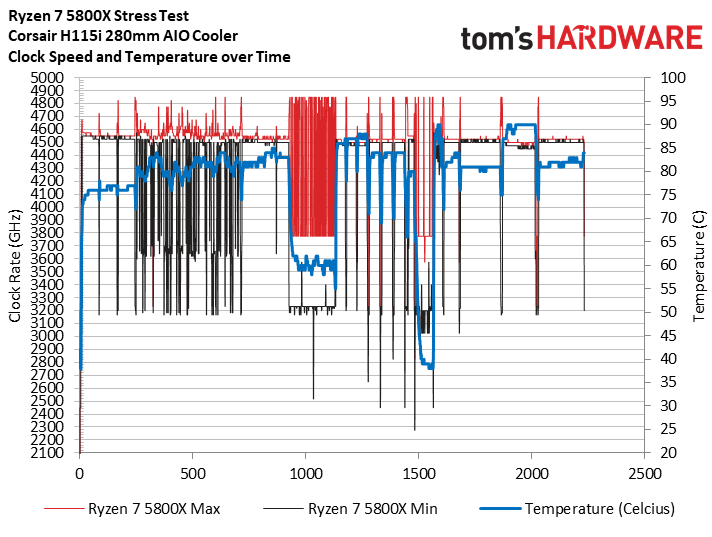
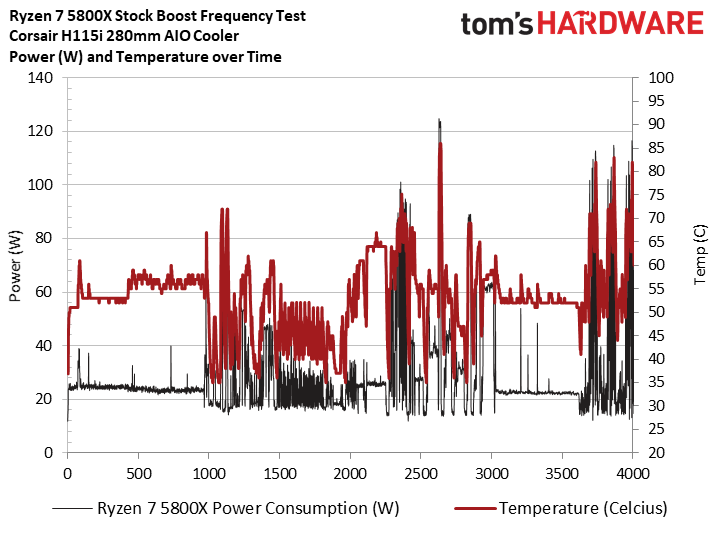
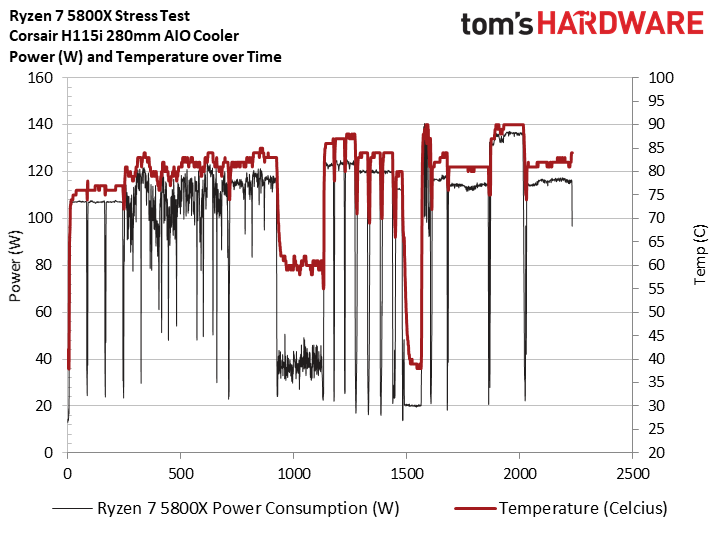
There really isn't too much to cover in the lightly-threaded series of tests; the big takeaway is that the Ryzen 7 5800X regularly exceeded its 4.7 GHz boost clock spec, albeit with our 280mm Corsair H115i cranking away at full speed, and hit 4.85 GHz very regularly during our test sequence.
Unlike with the Ryzen 3000 series processors, the unused cores (plotted in black) dropped as low as 2.2 GHz during the test (previous-gen chips tended to bottom out at 3.8 GHz). With Zen 3, AMD added the ability for individual idle cores to drop into sleep states quickly to reduce overall chip power consumption and heat generation. That technique allows the active cores can boost to higher frequencies, and they can boost more frequently and for longer durations.
The second series of tests plots our custom multi-threaded stress test that consists of multiple iterations of HandBrake, POV-Ray, Cinebench, v-ray, y-cruncher, and Blender renders. This is basically throwing the heaviest real-world workloads we have in our arsenal at the chip to see if we can push any active cores below the 5600X's 3.7 GHz base clock. It's important to note that all-core workloads that fully stress all the cores are represented in the areas where the red (maximum) and black (minimum) frequencies converge.
We recorded all-core boosts that generally landed in the 4.5 to 4.55 GHz range, and temperatures peaked (albeit for a short period) right at 90C, the maximum allowed temperature for AMD's 105W processors. Power consumption peaked at 140W, which is close enough to the 142W PPT limit (given expected variance) to say the processor, at stock settings, has the capability to extract the utmost power potential from the socket. That comes with the caveat that thermal conditions have to allow the chip to operate within that range - temperatures peaked at 90C, the limit, during the same time frame, indicating the chip was constrained by both thermal and power limits.

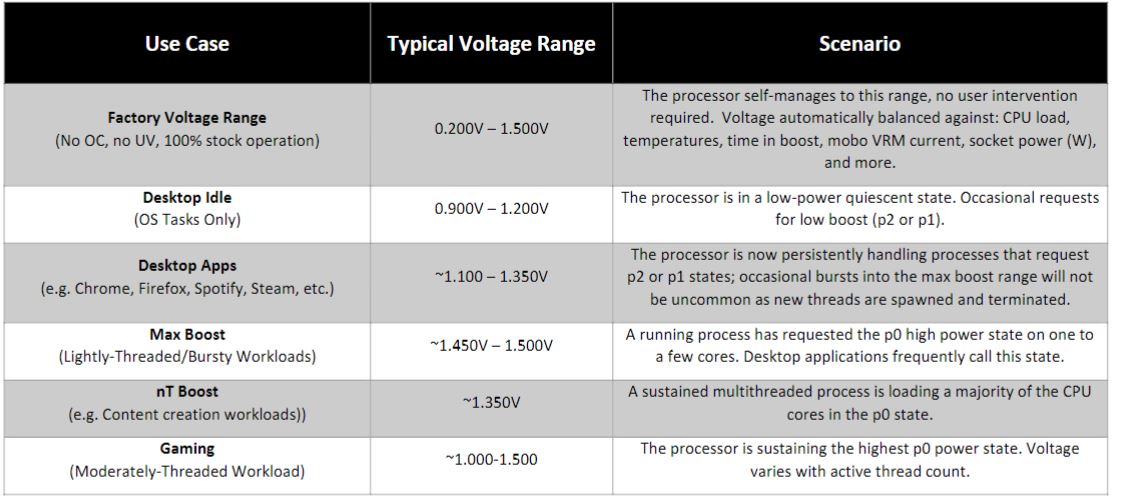
We recorded higher temperatures during our tests than we've seen with previous-gen Ryzen chips, but don't get too excited about the higher stock temperatures. AMD tuned its boost algorithms to fully leverage every last bit of the thermal headroom available, resulting in higher chip temperatures – even during comparatively lighter workloads. This doesn't pose any danger to chip longevity and ultimately results in better performance.
Get Tom's Hardware's best news and in-depth reviews, straight to your inbox.
To help align expectations, AMD issued the above guidelines for expected temperatures for various kinds of coolers and the expected voltage ranges for various workloads. Naturally, lesser coolers at more mundane settings will peak at higher temperatures.
Test Setup and Ryzen 7 5800X Overclocking
We've included our test system breakdown at the end of the article, and we also have the frequency, boost, and thermal testing following the gaming and application testing below.
Much like their previous-gen counterparts, the Ryzen 5000 series processors rarely achieve all-core overclocks that exceed the single-core boost frequency, so manual all-core overclocking results in less performance in lightly-threaded tasks. As such, we stuck with AMD's Precision Boost Overdrive (PBO), which boosts performance in multi-core workloads while maintaining the high single-core boost clocks. AMD has also announced its new Precision Boost Overdrive 2, which confers a slight performance boost in single-threaded work while also improving multi-threaded performance. Final BIOS revisions with the new feature roll out later this month, so be aware that our testing below leverages the standard Precision Boost Overdrive feature.
We've had great results with memory overclocking with the Ryzen 5000 series. However, while motherboard firmware is solid for stock and general overclocking use, it is still very much a work in progress for fabric overclocking. That impacts the peak memory frequencies you can attain while still using the 1:1:1 fclk/uclk/mclk ratio that provides the best results.
We've reached DDR4-4000 with a 2000 MHz fabric with other Ryzen 5000 processors, but we're limited to a 1900 MHz fabric speed for the Ryzen 7 5800X. As such, we dialed in DDR4-3800 at 16-16-16-36 timings for our 5800X PBO configuration. We had to dial the CCD and IOD voltage to 1.15V to stabilize the fabric frequency.
We conducted our testing with Windows 10 Pro (2004 build 19041.450) with the newest versions of each benchmark - with the exception of Cinebench R23 and v-ray 5, both of which recently launched. We'll add those tests in future reviews.
| Intel Socket 1200 (Z490) | Core i5-10600K, Core i7-10700K, Core i9-10900K |
| Row 1 - Cell 0 | Gigabyte Aorus Z490 Master |
| Row 2 - Cell 0 | 2x 8GB Trident Z Royal DDR4-3600 - Stock: DDR4-2933, OC: DDR4-4000 |
| AMD Socket AM4 (X570) | AMD Ryzen 9 5950X, 5900X, Ryzen 7 5800X, Ryzen 5 5600X, 3600XT, 3600X, 2600X, 1600X |
| MSI MEG X570 Godlike | |
| Row 5 - Cell 0 | 2x 8GB Trident Z Royal DDR4-3600 - Stock: DDR4-3200, OC: DDR4-4000, DDR4-3600 |
| All Systems | Gigabyte GeForce RTX 3090 Eagle - Gaming and ProViz applications |
| Row 7 - Cell 0 | Nvidia GeForce RTX 2080 Ti FE - Application tests |
| 2TB Intel DC4510 SSD | |
| EVGA Supernova 1600 T2, 1600W | |
| Row 10 - Cell 0 | Open Benchtable |
| Windows 10 Pro version 2004 (build 19041.450) | |
| Cooling | Wraith Stealth, Corsair H115i, Custom loop |
MORE: Best CPUs
MORE: Intel and AMD CPU Benchmark Hierarchy Comparisons
MORE: All CPUs Content
Current page: AMD Ryzen 7 5800X Boost Frequency, Thermals, Overclocking, Test Setup
Prev Page The Pricing No Mans Land Next Page Ryzen 7 5800X Power Consumption, Thermals
Paul Alcorn is the Editor-in-Chief for Tom's Hardware US. He also writes news and reviews on CPUs, storage, and enterprise hardware.
-
Co BIY "AMD's suggested selling prices rarely manifest at retail, and continuing shortages have found Ryzen 5000 chips selling far over recommended pricing. History indicates that, given sufficient supply, AMD's processors typically retail for far less than the official price points. That makes it hard to predict how pricing will shake out over the next months as supply normalizes. "Reply
Given current market conditions I would expect both AMD and Intel to be able to sell almost everything they make at the prices they want (plus some "obscene" profits for the retailers)
Intel has been able to sell everything they make for the last few years and made tons of money despite their 10nm problems and lack of enthusiast excitement for their incremental gains.
AMD is at parity or has a small lead in performance and can demand the same prices. They probably cannot easily increase production.
AMD's history of below MSRP prices is when they were second tier products in low demand. No reason to think that will be the case going forward on either the supply or the demand side. I don't think I would try waiting for an AMD 5800XT to drop below MSRP.
OTOH - Both AMD and Intel's mid-range chips should be the real competition for their high end products. Games are GPU bound and the mid-range offerings are more than adequate for even a high-end GPU if you can find one. This article clearly points to that sweet spot. -
Phobos258 The tests that put the 5800x PBO at the top of the list show why AMD feels like they can charge what they want for this chip.Reply
Price may suck but it's more available then the rest of the fleet right now. -
purple_dragon The only problem here is the fact you can't acquire a 5000 series chip easily. Whereas, Intel chips are readily available and the I7-10700k is the most reasonable cpu at the moment unless your lucky enough to stumble upon an in stock AMD cpu. Hopefully production catches up with demand soon but it probably won't until March or April 2021.Reply -
clsmithj I'm not in a market for a CPU, my ZEN+ & ZEN2 family CPUs are enough. But if one can get AMD and NVIDIA to kick-start production again of their graphics cards. That would be great.Reply -
Friesiansam "AGAINSTPriceReply
No bundled cooler
No integrated graphics" I don't think most buyers, at this level, are going to be bothered about points 2 and 3. I certainly wouldn't be. -
Remedailjoe Everyone who's commenting negatively obviously doesnt own this chip. My single scores are insane. Hands down destroys anything in intels line up. PBO uses voltage I dont like but it maybe my mobo. Gigabyte x570 Aorus Master.. Hits 1.5volts so i disabled it and set all core 4.85ghz at 1.375volt... Shattered-Dreams #8 CpuZ validation at 5.05ghz. On cell so no link. Over 690 single core.Reply
As for ram I can easily oc my ram 3600 gskill ripjaw 4x8gb to 4200 at 1.45v cl19. Ram oc is all in the motherboard.. And using realistic timings.. -
zodiacfml The 5800x is Amd's perfect silicon, only next to the 16 core. The price is justified being way ahead of its time unlike the 5600x which is perfext for current and existing gamesReply -
mikie tim t With AMD constrained from TSMC, they need to get as much money as they can with the wafers they get. They will have no shortage of I/O dies as they are 12nm from Global Foundries, so it makes absolute business sense to get as much money right now as they can with the inputs they have available, which means that 5800X is going to be what they push out the doors until they have enough lower quality chiplets to boost production of 5600X and 5900X, respectively. I was able to get a 5800X from the Overland Park, KS MicroCenter at MSRP, and it has been a night and day difference in responsiveness on everything over the 3600X it replaced, which wasn't particularly slothful. I don't feel shortchanged at all, quite frankly. I hope AMD can pull as much market share as possible from Intel these next few quarters, because that's what it will take to move both companies to better execution, to the benefit of us all.Reply -
mrv_co I get the argument on paper that the 5800x is overpriced, but that argument has been strictly an intellectual one to date. I also don't doubt that once supply finally outpaces demand, the street price will adjust accordingly. Regardless, bring on the 5700x for my SFF upgrade!Reply